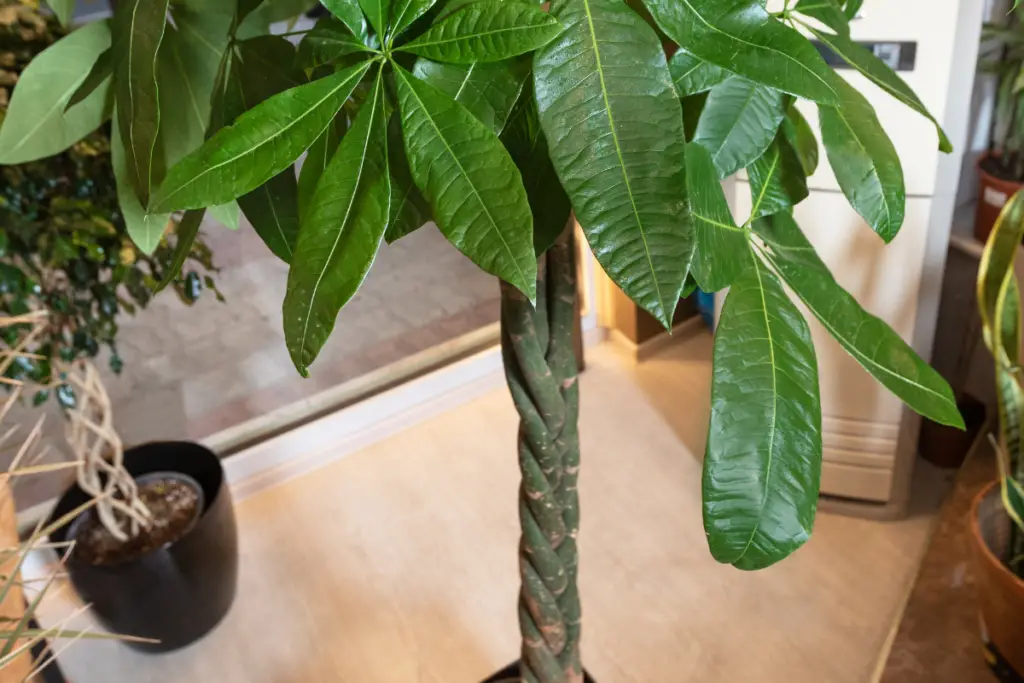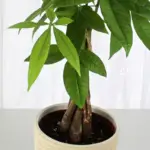Money Trees are a popular houseplant due to their attractive appearance and low maintenance requirements.
However, overwatering is a common mistake made by plant owners that can lead to root rot, a fungal disease that can be fatal to the plant if left untreated.
Signs of root rot in Money Trees include wilting leaves, discolored leaves, soft trunks, slowed growth, and a mildewy smell.
If you suspect that your Money Tree has root rot, it is important to act quickly to save the plant. The key to defeating root rot is to catch it in time and avoid its causes in the first place.
Thankfully, an infected plant can usually be salvaged if treated before the rot advances.
Common causes of Money Tree root rot include overwatering, poor drainage, and cross-contamination from other infected plants.

Table of Contents
Understanding Root Rot
Root rot is a common problem that affects money trees and many other houseplants. It is caused by a fungal or bacterial infection that attacks the roots of the plant, leading to their decay.
Root rot can be fatal if left untreated, as it can cause the plant to wilt, turn yellow, and eventually die.
The main cause of root rot in money trees is overwatering. When the soil is too wet, the roots cannot get enough oxygen, and they begin to rot.
Other factors that can contribute to root rot include poor drainage, using contaminated soil, and planting the tree in a pot that is too small.
One of the first signs of root rot is yellowing leaves that may eventually fall off. The leaves may also appear wilted or droopy, and the plant may stop growing.
If you suspect that your money tree has root rot, you should investigate the roots by gently removing the plant from its pot.
Healthy roots should be white or light brown and firm to the touch. If the roots are black, slimy, or mushy, they are likely infected with root rot. In severe cases, the roots may have a foul odor.
Preventing root rot is the best way to protect your money tree. To prevent overwatering, make sure that the soil is well-draining and that the pot has drainage holes.
Water the plant only when the top inch of soil is dry to the touch. If you are using contaminated soil, consider sterilizing it before planting your money tree.
Signs of Root Rot in Money Trees
Money trees are popular indoor plants that are easy to care for. However, they are susceptible to root rot, a condition that can be fatal if not treated promptly.
Here are some signs to look out for if you suspect your money tree has root rot:
Yellowing Leaves
One of the first signs of root rot in money trees is yellowing leaves. The leaves may turn yellow and fall off, even if the plant is not being overwatered.
This is because the roots are not able to absorb nutrients from the soil due to the rot.
Wilting or Drooping
Another sign of root rot in money trees is wilting or drooping leaves. This is because the roots are not able to support the plant properly, causing it to wilt or droop.
The leaves may also feel soft or mushy to the touch.
Dark and Mushy Roots
If you suspect root rot in your money tree, check the roots for signs of decay. Healthy roots should be firm and white.
However, if the roots are dark and mushy, this is a sign of root rot. You may also notice a foul smell coming from the soil.
Slow Growth
Finally, if your money tree is not growing as quickly as it should, this could be a sign of root rot. The plant may appear stunted, with small leaves and a general lack of vigor.
This is because the roots are not able to absorb the nutrients needed for growth.
In conclusion, if you notice any of these signs in your money tree, it is important to take action immediately to prevent further damage.
By identifying the signs of root rot early, you can save your money tree from potential death.
Causes of Root Rot in Money Trees
Money trees are popular indoor plants that can add life and beauty to any room. However, they are susceptible to root rot, a fungal disease that can cause the roots to decay and eventually kill the plant.
Root rot is often caused by overwatering, poor drainage, and unsuitable soil.
Overwatering
One of the most common causes of root rot in money trees is overwatering. When the soil is constantly wet, the roots are unable to absorb oxygen, leading to the growth of harmful fungi that can cause root rot.
Signs of overwatering include yellowing leaves, wilting, and a foul odor coming from the soil.
To avoid overwatering, it is important to let the soil dry out between watering. Money trees prefer to be kept on the drier side, so it is best to wait until the top inch of soil is dry before watering again.
It is also important to use a well-draining soil mix to prevent water from pooling around the roots.
Poor Drainage
Poor drainage is another common cause of root rot in money trees. When the soil does not drain properly, water can accumulate around the roots, creating the perfect environment for fungal growth.
Signs of poor drainage include standing water on the soil surface, a foul odor from the soil, and yellowing leaves.
To improve drainage, it is important to use a pot with drainage holes and a well-draining soil mix.
It is also important to avoid placing the plant in a saucer of water or allowing water to accumulate on the soil surface.
Unsuitable Soil
Using unsuitable soil can also lead to root rot in money trees. Soil that is too dense or does not drain well can prevent water from moving away from the roots, creating a damp environment that is conducive to fungal growth.
Signs of unsuitable soil include slow growth, yellowing leaves, and a foul odor from the soil.
To prevent root rot due to unsuitable soil, it is important to use a well-draining soil mix that is specifically formulated for indoor plants.
A good soil mix should contain a combination of peat moss, perlite, and vermiculite to promote drainage and aeration.
In summary, root rot in money trees is often caused by overwatering, poor drainage, and unsuitable soil.
By following proper watering and soil practices, you can prevent root rot and keep your money tree healthy and thriving.
How to Fix Root Rot
Money trees are popular houseplants that can be prone to root rot if not properly cared for. Root rot is a fungal disease that can cause the roots to rot, leading to wilting, yellowing, and eventually death of the plant.
Here are some steps to fix root rot in money trees:
Root Pruning
The first step to fixing root rot in money trees is to prune the affected roots. Use a clean and sharp pair of scissors or pruning shears to remove the infected roots.
Cut off any brown or black roots, as these are likely affected by the fungus. Be sure to sterilize your tools with rubbing alcohol or bleach before and after use to prevent the spread of the disease.
Repotting
Once you have pruned the affected roots, it’s time to repot your money tree. Choose a clean pot that is slightly larger than the current one, with good drainage holes.
Fill the bottom of the pot with a layer of gravel or rocks to improve drainage. Then, fill the pot with fresh, well-draining soil mix.
Gently place the money tree in the pot and fill in any gaps with soil. Be sure not to bury the trunk of the plant too deep in the soil.
Changing Watering Habits
One of the most common causes of root rot in money trees is overwatering. To prevent root rot from recurring, it’s important to change your watering habits.
Water your money tree only when the top inch of soil feels dry to the touch. Be sure not to let the soil dry out completely, as this can also be harmful to the plant.
Water the plant slowly and deeply, allowing the water to seep through the soil and out the drainage holes.
Improving Drainage
Another way to prevent root rot in money trees is to improve drainage. Make sure your pot has adequate drainage holes and that the soil is well-draining.
You can also add a layer of gravel or rocks to the bottom of the pot to improve drainage.
Avoid placing your money tree in a saucer filled with water, as this can cause the roots to sit in water and lead to root rot.
Using Fungicides
If your money tree has severe root rot, you may need to use a fungicide to treat the remaining healthy roots.
Choose a fungicide that is safe for indoor use and follow the instructions carefully. Be sure to wear gloves and a mask when applying the fungicide, as it can be harmful if ingested or inhaled.
Repeat the treatment as necessary until the root rot is completely cured.
By following these steps, you can fix root rot in your money tree and prevent it from recurring in the future.
Remember to monitor your plant closely and adjust your care routine as needed to keep it healthy and thriving.
Preventing Root Rot in Money Trees
Money trees are popular indoor plants that are easy to care for. However, they are susceptible to root rot, which can be caused by overwatering, poor drainage, and using the wrong soil.
Here are some tips to prevent root rot in money trees.
Proper Watering
Watering is one of the most important factors in preventing root rot. Money trees should be watered when the top inch of soil is dry to the touch.
Overwatering can lead to standing water in the pot, which can suffocate the roots and promote the growth of harmful bacteria and fungi.
To avoid overwatering, it is recommended to use a well-draining potting mix and a pot with drainage holes.
It is also important to avoid letting the plant sit in standing water for extended periods of time. If the pot does not have drainage holes, consider drilling some in the bottom to allow excess water to escape.
Good Drainage
Good drainage is essential for preventing root rot. When the soil does not drain well, water can accumulate in the pot and suffocate the roots.
To improve drainage, consider adding perlite or sand to the soil mix. These materials can help create air pockets in the soil and allow water to flow through more easily.
It is also important to choose a pot that has drainage holes. If the pot does not have drainage holes, consider drilling some in the bottom to allow excess water to escape.
Additionally, make sure to empty the saucer under the pot after watering to prevent the plant from sitting in standing water.
Right Soil
Choosing the right soil is another important factor in preventing root rot. Money trees prefer well-draining soil that is rich in nutrients.
It is recommended to use a potting mix that contains peat moss, perlite, and vermiculite.
Avoid using heavy soils or soils that retain moisture for too long, such as garden soil or clay soil. These types of soils can suffocate the roots and promote the growth of harmful bacteria and fungi.
By following these tips, you can prevent root rot and keep your money tree healthy and thriving.
Remember to water the plant only when the top inch of soil is dry to the touch, use a pot with drainage holes, and choose a well-draining soil mix.
Conclusion
In conclusion, root rot is a common problem that affects money trees and can lead to their death if not addressed in time.
Overwatering is the main cause of root rot, but other factors such as poor drainage, lack of oxygen, and fungal infections can also contribute to the problem.
To fix root rot in money trees, it is important to stop watering the plant immediately and cut off any infected roots.
The remaining healthy roots should be treated with a fungicide to disinfect them completely. Once the roots have been treated, the money tree should be transferred to a clean pot with a sterile, well-draining soil mix.
Preventing root rot in money trees involves proper watering techniques, ensuring good drainage, and using a well-draining soil mix.
It is important to water the plant only when the top inch of soil feels dry to the touch and to avoid overwatering.
Additionally, it is recommended to use a pot with drainage holes to allow excess water to drain away from the roots and to use a soil mix that contains perlite or sand to improve drainage.
By following these steps, money tree owners can successfully fix root rot and prevent it from occurring in the future.
However, it is important to note that prevention is the best approach to dealing with root rot, as it is easier to prevent the problem than to fix it once it has occurred.
- How to Dry Basil Leaves: A Professional Guide
- Is an Avocado a Fruit or Vegetable? Simple Answer and Explanation
- Does Pineapple Have Seeds? Exploring the Anatomy of Pineapples
- Blooming Through Winter: Can I Grow Vegetables Indoors in the Winter?
- What Can You Grow in a Greenhouse All Year Round: A Guide to Year-Round Greenhouse Gardening
- Are Blueberries Blue? Debunking the Myth of Their Color
















